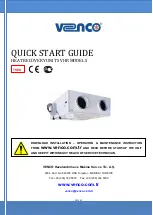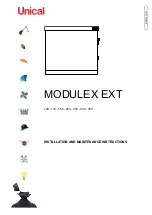
100A NO-GAS INVERTER MIG WELDER
MODEL NO:
MINIMIG100
Thank you for purchasing a Sealey product. Manufactured to a high standard, this product will, if used according to these
instructions, and properly maintained, give you years of trouble free performance.
IMPORTANT:
PLEASE READ THESE INSTRUCTIONS CAREFULLY. NOTE THE SAFE OPERATIONAL REQUIREMENTS, WARNINGS & CAUTIONS. USE
THE PRODUCT CORRECTLY AND WITH CARE FOR THE PURPOSE FOR WHICH IT IS INTENDED. FAILURE TO DO SO MAY CAUSE DAMAGE AND/OR
PERSONAL INJURY AND WILL INVALIDATE THE WARRANTY. KEEP THESE INSTRUCTIONS SAFE FOR FUTURE USE.
1. SAFETY
1.1.
ELECTRICAL SAFETY
WARNING
! It is the user’s responsibility to read, understand and comply with the following:
1.1.1.
You must check all electrical equipment and appliances to ensure they are safe before using. You must inspect power supply leads,
plugs and all electrical connections for wear and damage. You must ensure the risk of electric shock is minimised by the installation of
appropriate safety devices. An RCCB (Residual Current Circuit Breaker) should be incorporated in the main distribution board. We
also recommend that an RCD (Residual Current Device) is used with all electrical products. It is particularly important to use an RCD
together with portable products that are plugged into an electrical supply not protected by an RCCB. If in doubt consult a qualified
electrician. You may obtain a Residual Current Device by contacting your Sealey stockist. You must also read and understand the
following instructions concerning electrical safety.
1.1.2.
The Electricity At Work Act 1989 requires all portable electrical appliances, if used on business premises, to be tested by a qualified
electrician, using a Portable Appliance Tester (PAT), at regular intervals.
1.1.3.
The Health & Safety at Work Act 1974 makes owners of electrical appliances responsible for the safe condition of the appliance, and
the safety of the appliance operator. If in any doubt about electrical safety, contact a qualified electrician.
1.1.4.
Ensure the insulation on all cables and the product itself is safe before connecting to the mains power supply. See 1.1.1. & 1.1.2.
above and use a Portable Appliance Tester (PAT).
1.1.5.
Ensure that cables are always protected against short circuit and overload.
1.1.6.
Regularly inspect power supply leads, plugs and all electrical connections for wear and damage. Inspect power connections to
ensure that none is loose.
IMPORTANT:
Ensure the voltage marked on the product is the same as the electrical power supply to be used and check that plugs
are fitted with the correct capacity fuse. A 13 amp plug may require a fuse smaller than 13 amps for certain products,
see fuse rating at right.
8
DO NOT
pull or carry the powered appliance by its power supply lead.
8
DO NOT
pull power plugs from sockets by the power cable.
8
DO NOT
use worn or damaged leads, plugs or connections. Immediately replace or have repaired by a
qualified electrician. A U.K. 3 pin plug must be fitted according to the following instructions.
(UK only - see diagram at right).
Ensure the unit is correctly earthed via a three-pin plug.
a) Connect the green/yellow earth wire to the earth terminal.
b) Connect the brown live wire to live terminal.
c) Connect the blue neutral wire to the neutral terminal.
d) After wiring, check that there are no bare wires, that all wires have been correctly connected, that the
cable external insulation extends beyond the cable restraint and that the restraint is tight.
1.1.7.
Cable extension reels. When a cable extension reel is used it should be fully unwound before connection. A cable reel with an RCD
fitted is recommended since any product which is plugged into the cable reel will be protected. The section of the cable on the cable
reel is important and should be at least 1.5mm², but to be absolutely sure that the capacity of the cable is suitable for this product
and for others that may be used in the other output sockets, we recommend the use of 2.5mm² section cable.
WARNING!
Be very cautious if using a generator to power the welding set. The generator must be self-regulating and stable with
regard to voltage, wave form and frequency. The output must be greater than the power consumption of the welding set. If any of the
requirements are not met the electronics within the welding set may be affected.
NOTE: The use of an unregulated generator may be dangerous and will invalidate the warranty on the welding set.
Replacement
fuse rating: 13A
Original Language Version
© Jack Sealey Limited
Refer to
instructions
Welding sparks
can cause
explosions
or fire
Breathing
welding
fumes can be
hazardous to
your health
Wear eye
protection
Wear protective
gloves
Electric shock
from welding
electrodes can
kill
Wear safety
footwear
Wear protective
clothing
Electromagnetic
fields can cause
pacemaker
malfunction
Arc rays can
burn eyes and
injure skin
Keep away
from rain
Warning
Wear a
welding helmet
Minimig100 Issue 1 23/05/22























